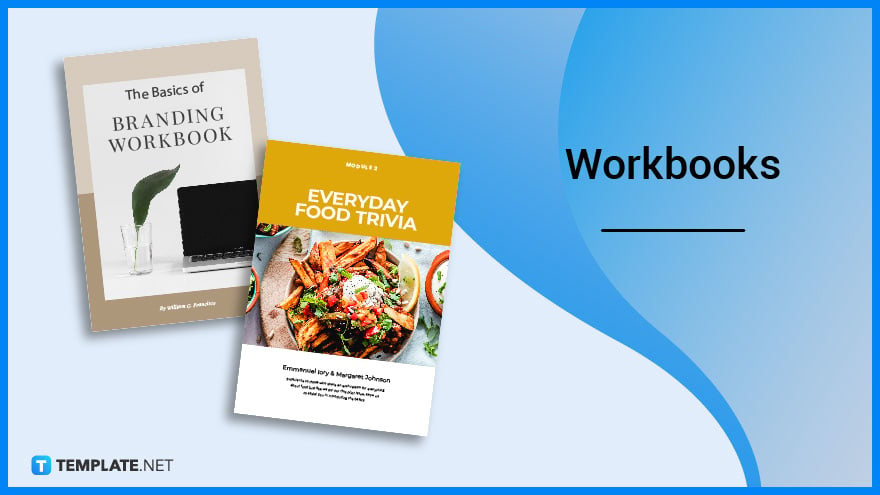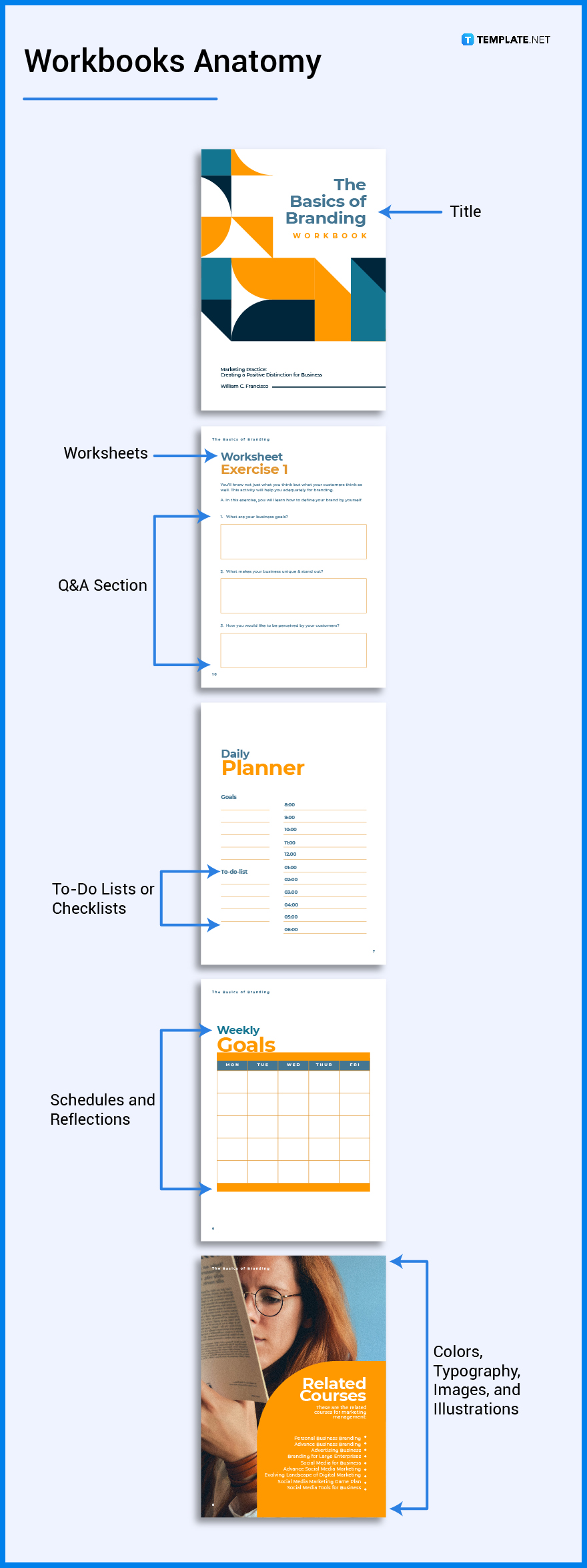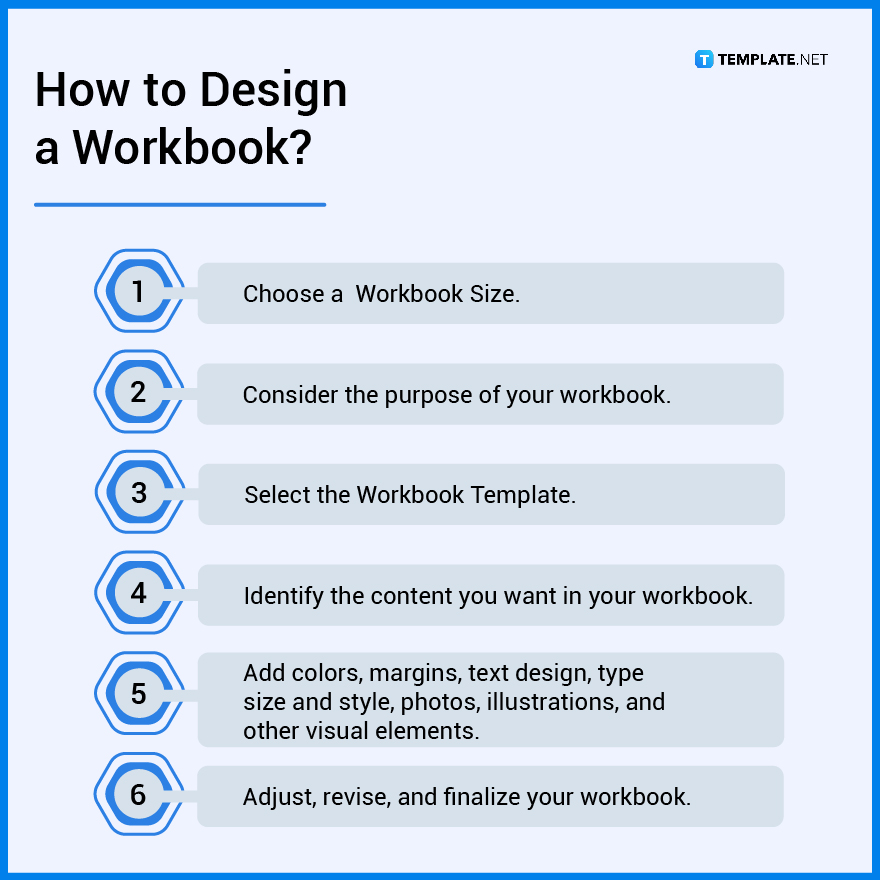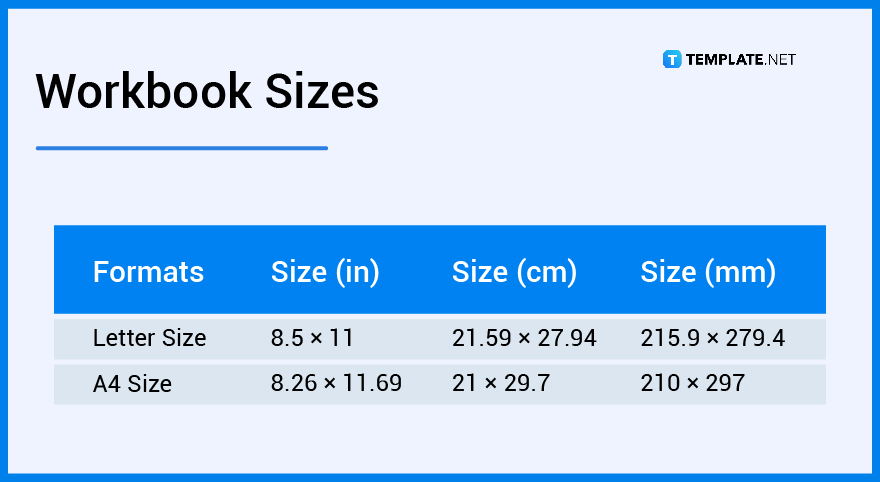![How To Create Meeting Minutes in Google Docs [Template + Example]](https://images.template.net/wp-content/uploads/2023/07/How-To-Make_Create-Meeting-Minutes-in-Google-Docs-Template-Example-788x443.png)
How To Create Meeting Minutes in Google Docs [Template + Example]
Meeting minutes Play a vital role in the recording of meeting information and details. In any kind of meeting, there is always…
Sep 02, 2025
Workbooks are educational and instructional tools generally used for academic institutions, businesses, schools, universities, and other learning organizations. Developing a clear and systematic workbook for your e-course, accounting, mindfulness activity, and/or any other project is fundamental in leading the readers and learners through the theory of the subject or topic and assisting them in solving and learning simpler and even more complex cognitive tasks.

A workbook is a self-instructional book composed of in-depth activities, simple to difficult tasks, self-reflection questions, and to-do lists or checklists arranged in worksheets.
Workbooks are key documentation and educational tools for many people, schools, universities, and organizations as they are mostly used for creating a period of critical thinking through diverse activities in order to boost the development of the basic intellectual abilities and skills of the learners.
A workbook is a learning aid mainly used by students as a source of knowledge during class, and for practicing what they have learned at home. Teachers and other academic professionals use this for measuring the students’ acquired knowledge. It is beneficial for the improvement of their understanding of the subject or topic they are learning, and for the application of what they have learned.
Whether you are managing a soft skills training or a strategy training program, writing an organized training workbook is helpful for the trainers and trainees to be equipped while learning. It is also called a training manual comprised of instructions that significantly improve the quality of one’s job, process, or work performance. Be creative while structuring your training workbook while planning your content and use a sample professional training workbook template like this.
This type of workbook provides crucial information to guide people through coaching conversations, the recommended frequency and structure of coaching sessions, and sample generative questions. A coaching workbook helps your coachee to reflect and find their way forward toward professional development. Include various activities and exercises to help in internalizing the coaching concepts, and identifying your personal coaching beliefs, and style while using our sample coaching workbook template below.
Accountants, bookkeepers, and other professionals use a financial workbook to organize their finances and gain a clear understanding of how they spend their money. It walks you through private financial counseling sessions with the use of worksheets, checklists, and assessments for financial health. Plus, it strongly focuses on financial issues that impact decision-making regarding personal money management, as well as building and managing wealth, and effective asset allocation.
A course workbook is a supplement to the lessons in a student’s online courses. Also known as an e-course workbook, it provides the students with the necessary reference materials and guides for them to complete the lessons properly. As a comprehensive self-study material, it also functions as both an informational review and starting point for the student in the preparation for their course exams.
Kindergarten teachers, preschool teachers, third-grade teachers, English grammar teachers, French language teachers, and many other teachers use a well-coordinated school workbook to guide their students in their studies. With this material, students are able to hone their skills in various subjects such as English, Science, Writing, etc. Easily download and use our customizable school workbook template here below.
Create a simple and cohesive branding workbook in PDF format to help small business owners or entrepreneurs to understand the importance of corporate branding. Explain how to create an effective brand identity for your company. This workbook guides you in defining your target market, finding your voice, and leveraging your social media presence, as well as designing a winning brand that will surely gain the trust of your prospective customers.
Make a well-structured lifestyle workbook for your health and wellness program! Provide guided self-assessments, exercises, and educational handouts about emotional, career, physical, social, and spiritual wellness. It helps many individuals to cope with anxiety and stress, strengthen their self-esteem, identify their physical needs, explore their leisure interests, determine whether they have developed healthy relationships, grow their spirituality, and identify major strengths and weaknesses.
A budget workbook is a simple way to manage your household finances. It organizes your finances with 12-month or one-year budgeting pages. Use this blank and editable budget workbook template to help you stay motivated in monitoring your expenses, and building your saving.
Prepare a marketing workbook to assist you in fine-tuning and growing the marketing capabilities of your business. It contains various activities designed in a worksheet form. Also, it takes many exercises related to marketing strategy planning, consumer behavior, segmentation, targeting and positioning, marketing research, new product development, and many others.
A digital workbook is a web-based interactive tool or e-book that helps learners and readers to access information about any new product content through their smartphones, tablets, laptops, and computers. When making a digital workbook, plan your content well, and add interactive elements to engage your target audience. Use some apps and software like MS Word, and Adobe InDesign to create an editable and fillable workbook.
A workbook provides a wide array of uses depending on the purpose of an academic institution, business firm, or professional. You can see different types of workbooks in numerous educational firms or learning organizations. Below is a list of the common uses, purposes, and importance of workbooks.
A well-designed workbook allows the reader or learner to be able to work at their own pace at the times best suited to their needs and preferences. For example, kids or students are able to work independently through the use of workbooks. They can work on hands-on learning, reading aloud, games, and many other activities included in the material.
Workbooks make the readers consciously think about the questions being asked and what they learned or realized. So, the short-answer and essay questions found in the workbooks enable them to enhance their critical thinking skills. This helps in boosting cognitive function and in gaining more skills in the future.
Many educators and teaching professionals use workbooks to their advantage for effective and easier lesson planning. Instead of going through piles of books and writing lesson plans over several weeks, teachers and instructors allow the learners to write their own lesson plans in their planners. They can also type out a quick assignment sheet if they want.
These materials guide the readers and learners in learning various instructions by themselves. That’s why they are mainly used in homeschooling education. Kids and young ones can have fun studying the subject or topic on their own through the instructions from the workbooks.
With the use of workbooks, schools, and teachers are able to organize information about their students and other learners in their educational institution. These workbooks are useful in storing and disseminating information with the minutest detail, and for comprehensive learning assessments and performance evaluations.
Write the title of your workbook and use clear and simple language when you write your workbook title. This will guide your readers to know what the workbook is all about.
Include some worksheets that contain several steps or fields that the readers must accomplish. Leave space so that they are able to make some calculations, and ask them to draw shapes like circles, and pictures or cross out some items from a list or fill in a chart or graph.
Create a brief and cohesive Q&A section by placing some open-ended questions for your reader. Also, leave some space for them to answer questions and reflect on the topic.
Invite the readers to create their lists. You may add a list of steps or action items or checklists that they need to take and add some space again for this section.
Construct a chart or spreadsheet to guide the readers in drafting their personal schedules. Add specific time windows, broken down by a certain time interval, and then, leave space for them to write their reflection or their innermost thoughts about what they have read or the activities they have accomplished throughout the workbook.
Choose an appealing two-tone color scheme or multicolored palette for your workbook. Be flexible when it comes to the text design, type size and style, and typography of your workbook, and use a size that is readable to your intended readers, as well as include various types of images like cartoons, illustrations, charts, graphs, etc.


A workbook is an educational and interactive tool designed to help students and other learners in practicing what they have learned from their academic classes or training programs.
A worksheet is a piece of paper that contains a set of questions and/or tasks to help students or individuals to exercise their newly acquired knowledge and skills by answering them and writing their own ideas and thoughts about the subject or topic.
A workbook is used to allow the readers and learners to answer interactive questions and practice various problems to generate logical solutions.
A textbook is an educational tool used in the teaching-learning process to provide the basic framework of a particular subject or topic being discussed in the classroom.
A journal is a document used in maintaining personal records and includes ideas, observations, experiences, priorities, reflections, and aspirations of the writer.
Workbooks have different standard sizes both in digital and print formats. The workbook size and format are based on the use and purpose of the business, organization, or individual.

There are different ways to show off your creativity when it comes to designing workbooks. Check out the following details for more workbook ideas and design inspiration.
When creating a workbook, make sure that your workbook is interactive so you need to construct worksheets, add a free response or Q&A section, include some lists, to-do lists or checklists, add schedules, and leave some space for the readers to write their reflections.
A student workbook is used by educators and teachers to support student learning and guide in their course of study as it contains different course exercises and questions.
Collect all the essential content for your education workbook, select the proper structure and layout, apply a conversational layout throughout the workbook, incorporate other supplemental content, and add a wide variety of interactive components.
A workbook template guides the learners to understand their previous knowledge, explore their abilities, build their confidence, become independent learners, and use their critical thinking skills in their studies.
A training workbook is a book that contains instructions to improve the quality of a performed activity or task in businesses and organizations.
A project management workbook is used by project managers, teams, members, and sponsors to closely track and monitor project activities and project progress.
It is a workbook used by accountants or bookkeepers use when it comes to preparing and collecting financial statements of the company.
A portfolio workbook is a type of workbook that visually represents the abilities, knowledge, professional skills, projects, accomplishments, and other milestones of an individual or a business firm.
In an Excel workbook, there are 255 worksheets in a single workbook.
Use similar texts and simply add in lines or spaces to allow the readers to write their answers to the questions, and change the overall format of your book by focusing more on the questions.
How do you create a workbook?
What is a student workbook?
How do I make an education workbook?
How does a workbook template help learners succeed?
What is a training workbook?
What is a workbook in project management?
What is a workbook in accounting?
What is a portfolio workbook?
How many worksheets are in a workbook?
How to turn your non-fiction book into a workbook?
![How To Create Meeting Minutes in Google Docs [Template + Example]](https://images.template.net/wp-content/uploads/2023/07/How-To-Make_Create-Meeting-Minutes-in-Google-Docs-Template-Example-788x443.png)
Meeting minutes Play a vital role in the recording of meeting information and details. In any kind of meeting, there is always…
![How To Make/Create a Manual in Google Docs [Templates + Examples] 2023](https://images.template.net/wp-content/uploads/2023/07/How-To-Make-Create-a-Manual-in-Google-Docs-788x443.png)
Manuals are essential instructional and reference guides. They help direct and inform an individual’s actions and also explain how to…
![How To Make/Create a Manual in Microsoft Word [Templates + Examples] 2023](https://images.template.net/wp-content/uploads/2023/07/How-To-Make-Create-a-Manual-in-Microsoft-Word-788x443.png)
Creating a manual can be a time-consuming and tedious task. However, manuals and other reference guides are necessary for organizations…
![How To Create a Legal Document in Google Docs [Template + Example]](https://images.template.net/wp-content/uploads/2023/07/How-To-Make_Create-a-Legal-Document-in-Google-Docs-Template-Example-2023-788x443.png)
When creating a legal document, there are a lot of things a person has to consider, and one of which is the…
![How To Make/Create a Contract in Microsoft Word [Template + Example] 2023](https://images.template.net/wp-content/uploads/2023/07/How-To-Make_Create-a-Contract-in-Microsoft-Word-Template-Example-2023-1-788x443.png)
Contracts can come in different forms and for different reasons but the most common thing is that when a company does business with…
![How To Create a Contract in Google Docs [Template + Example]](https://images.template.net/wp-content/uploads/2023/07/How-To-Make_Create-a-Contract-in-Google-Docs-Template-Example-2023-Step-788x443.png)
Contracts are an important part of any company or business, especially those that work with different companies or businesses. Companies…
![How To Make/Create a Report in Google Docs [Templates + Examples] 2023](https://images.template.net/wp-content/uploads/2023/07/How-To-Create-a-Report-in-Microsoft-Word-788x443.png)
A report is a comprehensive document that covers a wide array of topics from finance, research, incidents, feasibility studies, and…
![How To Make/Create a Report in Microsoft Word [Templates + Examples] 2023](https://images.template.net/wp-content/uploads/2023/07/How-To-Make_Create-a-Report-in-Microsoft-Word-Templates-Examples-20232-788x443.png)
A report is a document that contains information, data, analysis, finding, and other relevant information based on a specific topic.…
![How to Make/Create a Notebook in Google Docs [Templates + Examples] 2023](https://images.template.net/wp-content/uploads/2023/07/How-to-Make_Create-a-Notebook-in-Google-Docs-Templates-Examples-2023-788x443.png)
Notebooks always come in handy in writing important information or expressing our thoughts through written words. When we need a…